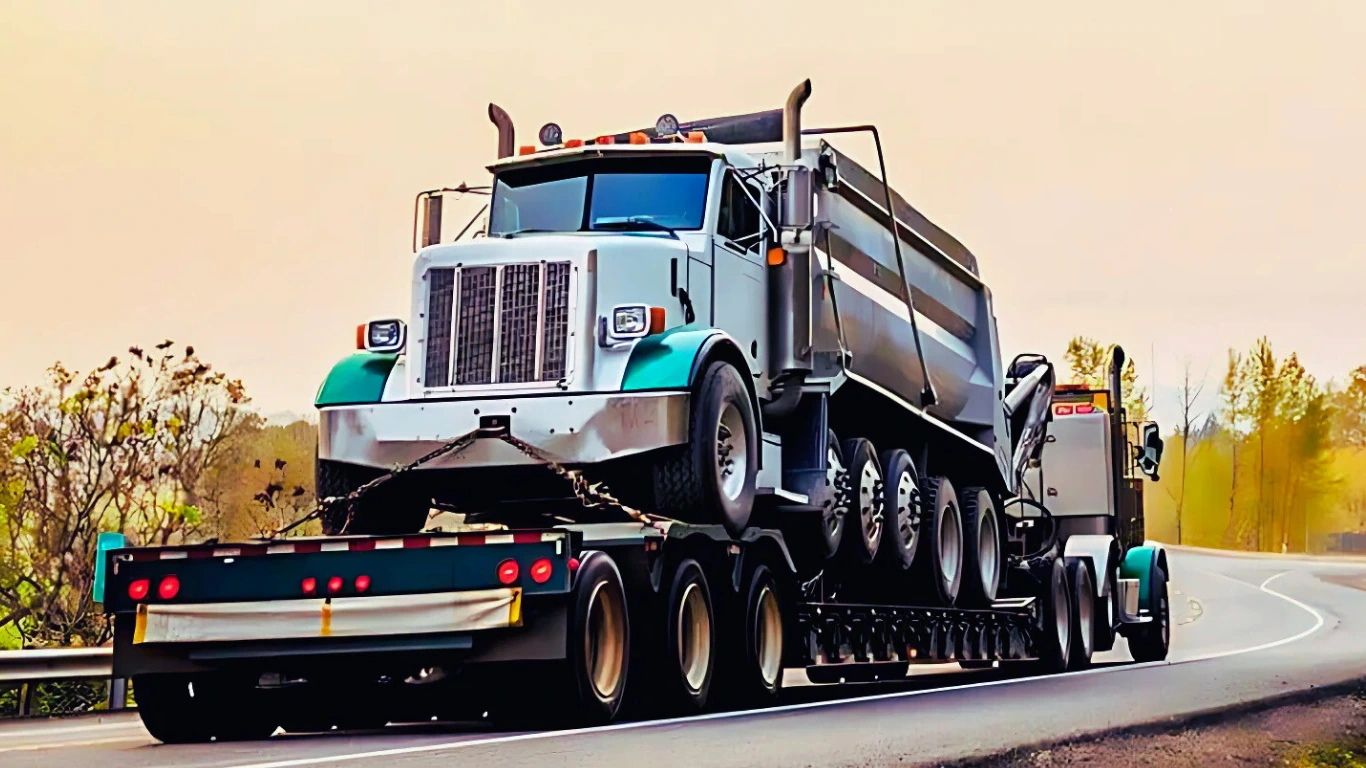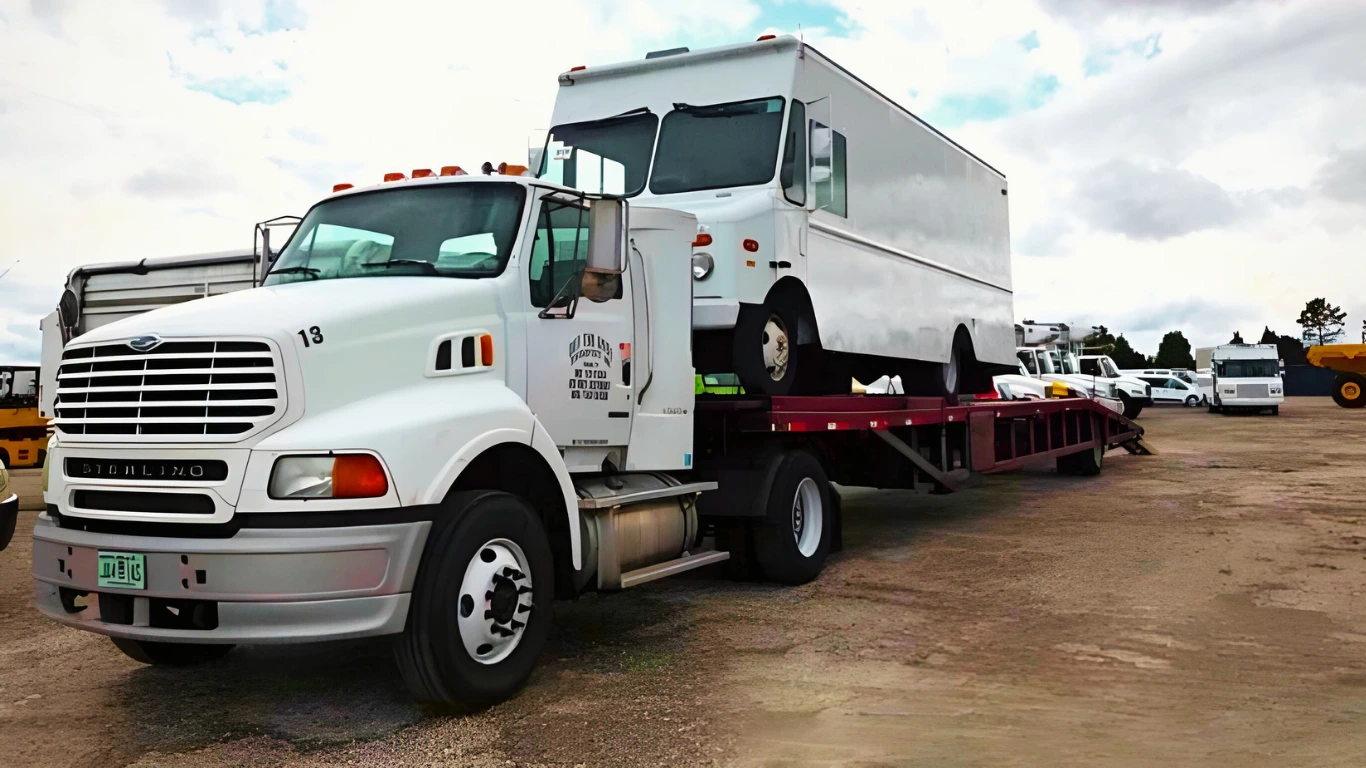
Best Truck Shipping Services
Rapid Auto Shipping is the nation's leading truck transport company. Standard truck transports, industrial truck shipping, and heavy load truck transporting are our specialties. Our transport services for shipping trucks are dependable, quick, and of high quality.
Types Of Truck Shipping
The height and weight of the load will determine the sort of trailer used to move your heavy-duty truck. A basic flatbed trailer will be used in most instances. A drop-deck/step-deck trailer is a preferable option if the vehicle is extremely tall. Because the trailer is so near to the earth, a lowboy trailer has even more height clearance.
A portable gooseneck trailer, on the other hand, can be used when a lift is required. This trailer can be rapidly removed and lowered down to load and discharge vehicles. We will decide on the best trailer for shipping trucks.
Flatbed Trucks: Flatbed vehicles transport goods on a trailer that is levelled and open, with no sides or top, thus the term flatbed. This design makes it simpler to load and unload big loads that would otherwise be too large for a normal 53-foot trailer. Straps, tarps, and other fastening devices are used to keep truck shipping fastened down on flatbeds.
Flatbed vehicles are commonly used as truck shipping for building materials, big made components, and different oversized loads. Any truck transporting that is wider than 8.5 feet is considered oversized cargo. This form of truck freight necessitates the use of red banners and lights to aid in the identification of oversized truck freight on the road.
Step Deck Trucks: Step deck trucks, like flatbed trucks, have an exposed, level platform. The primary distinction between truck shipping on a flatbed and step deck truck is that the step deck truck has a lower location that is positioned closer to the ground. This allows taller truck shipping to rest lower, avoiding possible dangers such as overpass clearances.
Gooseneck Trailer: These industrial trailers are frequently used to transport heavy cargo. They're nicknamed "goosenecks" because they have a curved expansion that looks like a goose's neck.
This extension is attached to the towing car immediately above the back axle. This provides more control when pulling.
They are frequently used to transport automobiles, livestock, horses, and heavy tools such as building machines. They're also common among "RVers" who use them to transport fifth-wheel trailers.

Professional Truck
Auto Transport
Rapid Auto Shipping, as a truck transports industry champion, can meet all of your heavy duty truck transporting needs. Whether you need shipping trucks across town or across the country, our equipment configurations can securely and effectively transport your pickup truck, dually truck, heavy duty truck, utility truck, or any other commercial truck to its location.
Transport Methods Available
Choose the shipping method that best fits your needs and budget
Door To Door Truck Auto Transport
One of the handiest methods of transporting a car is door to door auto transport. It is a car transfer choice in which the auto transporter picks up your vehicle and then delivers it to your house!
If the door to door car shipping trucks cannot directly enter due to its size, you and the driver will organize for pickup and transfer at a nearby spot. In this instance, all you have to do is enter a particular location for your car or another form of vehicle to be picked up and left off.
The most common auto transport carriers in the business are door to door, and door to door shipping is the most "cost-effective" way of moving a vehicle today. We provide door to door service to and from all states in the continental United States.
✓ Most Popular Choice
Terminal To Terminal Truck Auto Transport
Once upon a time, terminal to terminal auto transport was the preferred way of transporting automobiles across the nation. This was not unexpected; after all, the vehicle shipping business as we know it only became significant in the last 30-50 years.
And, before the building of the interstate highway system, the entire concept of shipping automobiles was, at best, speculative.
That gradually but steadily altered. Terminals, which were once so prevalent and convenient, started to be regarded as a bygone era. Why transport your car to someone to drop it off and wait until the carrier can come right to your door to collect it?
It just made sense, and over the last thirty years or so, "door to door transport services" have generally eclipsed terminal shipping.
✓ Traditional Method
Truck Shipping Services
Rapid Auto Shipping, as a truck transports industry champion, can meet all of your heavy duty truck transporting needs. Whether you need shipping trucks across town or across the country, our equipment configurations can securely and effectively transport your pickup truck, dually truck, heavy duty truck, utility truck, or any other commercial truck to its location.
Tanker Trucks
Transport tank vehicles safely throughout the United States. We can send any tanker vehicle used to carry gasoline, fuel, oil, gases, and a variety of other bulk liquids. Our expert haulers have the skills and certifications required to satisfy the stringent DOT rules for secure truck shipping.
Dually Trucks
Transporting a dually truck differs from transporting an automobile. While many transportation firms fail to handle such big trucks, we thrive. Regularly, we work with a variety of dually vehicle types, including lifted and modified trucks. Our seasoned and expert drivers will manage your vehicle most effectively and safely possible.
Utility Trucks
Every day, customers rely on us to move their utility vehicles. We comprehend the importance of utility trucks in your companies. Our mission is to get your truck to its location as quickly and safely as feasible. We have the equipment and expertise to ship your truck across town or the nation.
Semi Tractor Trucks
We provide the most practical and stress-free method of transporting your semi-tractor to and from anywhere in the United States. We guarantee the secure and simple loading and unloading of any heavy duty vehicle, regardless of size, by using our step decks, RGNs, and other specialized trailer equipment.
Get The Truck Ready For Shipping
Damage is one of the worst things that can happen to a vehicle while it is being transported. In the United States, 5% to 10% of vehicles are harmed during transport. However, by correctly preparing your vehicle for transport, you can reduce the chance of harm.
Examine for and record any previous harm. This can be accomplished in a few simple steps:
Wash your vehicle thoroughly.
Keep track of any cracks, dents, scratches, or other superficial harm.
Take photos of the vehicle from various perspectives, as well as close-ups of any damage.
Date the photos as well as the written document.
Check that the transporter, in addition to your documents, makes a formal notation.
Positive Characteristics Of A Reliable Truck Shipping Company
When transporting a truck, you must deal with experts. Whether you need a pickup vehicle for your local business or heavy duty corporate Truck Shipping, it must be done correctly.
We comprehend the significance of correctly shipping trucks because they are frequently a part of your income. Every stage will be guided by a transportation expert.
We make certain that you comprehend how to prepare your vehicle for transfer so that you are ready to go when the driver comes. You want to be confident in the support you receive when shipping a vehicle. We at Rapid Auto Shipping are committed to offering excellent vehicle transportation.
The Advantages Of Using Rapid Auto Shipping To Shipping Trucks
High Quality Services
The foundation of our relationship with providers is dependability. The best DOT safety ratings, cargo insurance, vehicle liability, and sector licences are all upheld by our carriers.
Speed And Reliability
Based on our knowledge and carrier network, we optimize freight and shipment paths and pricing. To guarantee a smooth process, our qualified logisticians plan out the complete shipment.
Complete Logistics
We handle permits, schedule pilot vehicles, coordinate with local officials and utilities, and ensure that seasoned carriers deliver your goods.
Emergency Transportation
If a vehicle breaks down, we have numerous trucks on standby to guarantee your cargo gets on time. We can send equipment to finish the delivery with a single phone contact.
How Much Does It Cost Shipping Trucks?
The expense of truck shipping can vary between a few hundred and a few thousand dollars. Depending on the distance traveled it may be more
Truck transporting prices are determined by a variety of variables. This includes, but is not limit to, the following:
Get Your Custom Quote
A Rapid Auto Shipping logistics agent will collect the information and locate the most affordable price to shipping trucks.
We provide all-inclusive business truck transportation estimates with no hidden costs. Each estimate is tailored to your specific heavy duty vehicle transportation requirements.
Calculating truck shipping costs is not easy. Various factors will influence the price of your vehicle's transport. To receive an estimate cost, we recommend filling out the quote form.
Call immediately for a no-hassle freight shipping estimate!
How To Choose A Truck Shipping Company?
Once you've finished your listing, truck transporters will contact you with shipment quotes as they compete for your business. You can speak with the transporters immediately as their estimates arrive. Learn more about their truck transportation expertise and the services they offer.
How Can I Track My Shipping Trucks?
You only need to submit us a request for car position tracking if you want to follow your vehicle's travels. You'll need your name, tracking number, phone number, email address, and/or postal code. Then we'll start working
Rapid Auto Shipping provides an online tracking system, which can be entered into their web tracking software. This will allow you to track your vehicle and ensure that it is secure and on schedule
This online monitoring system choice is becoming more popular in recent years. Furthermore, you may easily receive real-time details during the transport task that you have paid for.
Ready to Ship Your Truck?
Get a no-hassle freight shipping estimate today. Our logistics experts are standing by to help you with all your truck transportation needs across the continental United States.

0 Yr
In the business
0K
Quotes
0K
Vehicles Shipped
0.0/5
Overall Rating
How Can I Get Truck Shipping Quote?
Allow Rapid Auto Shipping to handle your heavy duty truck shipping and hauling requirements. We offer high quality truck transportation at the most competitive rates
To obtain a shipping quote, please contact us toll-free at +1 (833) 233-4447 or complete our online auto shipping quote calculator form. We are excited to serve you!

Everything you need to know about our auto transport services
We transport all kinds of trucks—pickup trucks, box trucks, duallys, flatbeds, service trucks, commercial trucks, lifted trucks, and more. Whether it's standard or oversized, we've got the right equipment.
Truck shipping costs depend on the vehicle's size, weight, distance, condition, and whether you choose open or enclosed transport. Get a free, accurate quote by contacting us directly.
Yes. We provide truck transport services across all 50 states with door-to-door and terminal-to-terminal options, including service to remote and commercial areas.
Absolutely. We specialize in transporting non-running, lifted, or modified trucks using winches, flatbeds, or lowboy trailers, depending on the truck's specs.
Yes. Your truck is fully insured while in transit, and we provide a detailed inspection at both pickup and delivery to ensure peace of mind.
You can request a quote online or call us. Our transport specialists will walk you through the process, from booking and paperwork to pickup and delivery.
